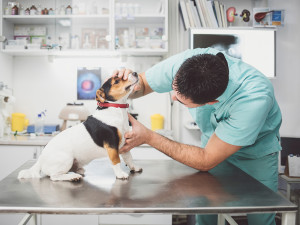Spleen Tumor In Dogs—How to Treat This Condition
And the signs to look for.

Share Article
In This Article:
Spleen Tumor in Dogs Canine Spleen Tumor Symptoms What Causes Spleen Tumors in Dogs? Canine Spleen Tumor: Treatment and Prognosis What Percentage of Spleen Tumors in Dogs Are Benign?
Spleen tumors are common in dogs, especially older, larger-breed ones. These tumors can go unnoticed for some time before they rupture and bleed, which can turn into a medical emergency. Finding out that your dog has a splenic tumor can be devastating and overwhelming. But fortunately, some are benign and treatment is available.
Spleen tumor in dogs
The spleen is an oval-shaped organ that sits near the stomach. Its main duties include producing and storing red and white blood cells, filtering the blood, and playing a part in the immune response. A spleen tumor in dogs is a growth that forms on this organ. Some canine spleen tumors are benign, while others can be cancerous. These tumors can sneakily grow over time without causing any symptoms until the day that it does. If the tumor ruptures or starts bleeding, it can cause sudden, dramatic symptoms. Unfortunately, splenic tumors are common in older, large-breed dogs, including German Shepherds, Labrador Retreivers, and Golden Retreivers.

Canine spleen tumor symptoms
It’s pretty common for dogs with splenic tumors to have a “little bleed before the big bleed.” In my experience, many cases of spleen tumor rupture in dogs have evidence of minor bleeding before showing up to the ER — episodes that either didn’t seem like a big deal at the time or that the dog bounced back from quickly. When a dog’s splenic tumor has mild bleeding, they may have decreased energy or appetite for a day or so, then go back to acting normally.
When I diagnose a splenic tumor, I usually talk to the dog’s family about how their pet has been doing over the past several days or weeks. A lot of the time, they’ll mention something that fits the pattern of a small bleed. They may say something like, “She seemed a little off last Wednesday. She didn’t get excited for her walk and didn’t finish her dinner. But she was normal again by Thursday. Other than that, there were no signs that anything was wrong.”
That’s a common experience for dog parents. In many cases, we only discover a tumor on the spleen in dogs when there’s a medical emergency that can present symptoms such as:
Lethargy
Weakness
Pale gums
Collapse
Labored breathing
Abdominal distension
Abdominal pain
Anorexia
Diarrhea
Cool limbs
What causes spleen tumors in dogs?
Sometimes we never figure out what causes tumors on dog spleens, but in many cases, the mass is either the result of hemangiosarcoma or a hemangioma.
Hemangiosarcoma
Hemangiosarcomaopens in new tab is a cancer of the blood vessels. Because there are blood vessels all over the body, this cancer tends to be aggressive and spread to multiple organs. Canine hemangiosarcoma tends to arise in the spleen, skin, and heart.
Hemangioma
A hemangioma is essentially a blood blister, or a pocket of blood. Hemangiomas are benign, but they can grow to be quite big; they can also become ulcerated and rupture. There’s no definitive way to determine if the mass on a dog’s spleen is benign or cancerous without surgically removing it, though some say that the larger it is, the more likely it is to be benign.
Other cancers
Although hemangiosarcoma and hemangioma are most commonly seen, other types of cancer can cause splenic tumors in dogs. Canine spleen tumors can also be caused by lymphoma, mast cell tumors, plasma cell tumor, and sarcoma.
Canine spleen tumor: Treatment and prognosis
Because many canine spleen tumors are found during a medical emergency, stabilization is needed right away; sometimes even before a diagnosis is made. The internal blood loss caused by a splenic tumor rupture can lead to poor circulation, low blood pressure, and inadequate oxygen levels.
Stabilization may include IV fluid therapy, pain medications, blood transfusions, and supplemental oxygen. This buys the veterinary team some time to get a diagnosis.
How are spleen tumors in dogs diagnosed?
Splenic tumors in dogs are usually diagnosed using physical exam and imaging, but the type of tumor cannot be diagnosed without removing the spleen for further testing. Before a dog’s spleen tumor ruptures, the dog may have abdominal pain or a palpable mass. Blood loss after tumor rupture can cause shock due to poor circulation. Dogs may also have a large, fluid-filled belly.
Imaging can be used to confirm a vet’s suspicions of a splenic tumor. Abdominal ultrasound is often the most useful method. A full abdominal ultrasound can confirm the presence of a splenic mass and also look for evidence of disease in other organs in the abdomen. In a medical emergency, a quick peek with an ultrasound can confirm fluid in the abdomen and sometimes the presence of a mass. A sample of this fluid can be collected with a small needle and syringe to confirm that it’s blood.
Before surgery, a vet will likely want to perform blood work and check clotting times to determine if the dog is anemic from blood loss or if there are any other concerns that should be addressed immediately.
Radiographs (x-rays) of the chest are recommended before surgery to look for signs of metastasis in the lungs. Sometimes this is the only pre-surgery indication that the mass in the dog’s spleen is cancerous.
What is the treatment for splenic tumors in dogs?
Surgery is the recommended treatment for canine splenic tumors, regardless of if they’re benign or malignant. Surgery will remove the source of the blood loss, lessen abdominal discomfort from large tumors, and allow for further testing to determine the type of tumor present. Because of the nature of the spleen’s tissue, the entire spleen needs to be removed, not just the tumor. This surgery is called a splenectomy.
If a tumor is diagnosed during a “little bleed” or when there is no bleeding yet, surgery is still recommended, though it may not need to be performed on an emergency basis. Supportive care can be provided in the short term, but eventually, the tumor is likely to bleed significantly. It’s much safer to perform a splenectomy on a stable patient than a dog that’s already collapsed due to blood loss.
After the surgery is performed, if cancer is confirmed, chemotherapy may be started to help fight the cancer. Dogs diagnosed with hemangiosarcoma tend to live longer if they undergo chemotherapy after surgery, though some dog parents opt for surgery to be the extent of the treatment — and that’s okay. There’s no right or wrong answer here.
Can a dog live without a spleen?
A dog can live a very normal life without a spleen. The spleen’s functions include storing and filtering blood as well as aiding in fighting infection. While these are all important jobs, the spleen is redundant in these roles. The main downside is that if a dog without a spleen has sudden blood loss, they won’t have the spleen’s blood reserve to pitch in and help.
What’s the prognosis for canine spleen tumor?
If a mass in a dog’s spleen is determined to be from hemangiosarcoma, expected survival time is four to nine months with chemotherapy and two weeks to three months without it. If a dog’s splenic mass turns out to be benign, surgery is curative.
What percentage of spleen tumors in dogs are benign?
Vets typically followed a “two-thirds rule” when discussing the likelihood of a tumor on a dog’s spleen being from underlying cancer: two-thirds of them are cancerous and two-thirds of those are hemangiosarcoma. More recent studies suggest that the percentage is actually closer to a little over 50 percent. Even with slightly better odds, deciding on surgery can be a tough call, especially when there are no guarantees.
When I talk to a dog parent who just learned of their dog’s splenic tumor, one of the more frustrating aspects of making a decision about pursuing surgery is the unknown. We don't know if the tumor on the dog’s spleen is benign or malignant until after we perform the surgery. Unless there are signs of cancer spread seen on x-rays or during surgery, we just don’t know until the spleen has been removed and tested.
The bottom line: Spleen tumors in dogs
Splenic tumors are common in older dogs. Many of these tumors are due to an aggressive, metastatic cancer like hemangiosarcoma, but they can also be benign. If a dog’s spleen tumor ruptures and bleeds, it can lead to sudden weakness and collapse. Treatment involves surgical removal of the spleen.
References
De Nardi, Andrigo Barboza et al. “Diagnosis, Prognosis, and Treatment of Canine Hemangiosarcoma: A Review Based on a Consensus Organized by the Brazilian Association of Veterinary Oncology, ABROVET.” Cancers vol. 15,7 2025. 29 Mar. 2023, doi:10.3390/cancers15072025opens in new tab
Delamarter, Marissa. “Splenic Masses in Dogs: Algorithms for Differentials, Diagnosis, and Definitive Treatment.” Today’s Veterinary Practice, 14 June 2024, todaysveterinarypractice.com/soft-tissue-surgery/splenic-masses-in-dogs-differentials-diagnosis-and-treatment-algorithm/opens in new tab.
Ziogaite, Brigita et al. “Incidence of splenic malignancy and hemangiosarcoma in dogs undergoing splenectomy surgery at a surgical specialty clinic: 182 cases (2017-2021).” PloS one vol. 19,12 e0314737. 3 Dec. 2024, doi:10.1371/journal.pone.0314737opens in new tab
“Tumors of the Skin in Dogs - Dog Owners.” Merck Veterinary Manual, www.merckvetmanual.com/dog-owners/skin-disorders-of-dogs/tumors-of-the-skin-in-dogsopens in new tab.

Dr. Alycia Washington, DVM, MS
Alycia Washington is a small-animal emergency veterinarian with over 10 years of experience based in North Carolina. She works as a relief veterinarianopens in new tab and provides services to numerous emergency and specialty hospitals. She also works as a veterinary writer with a focus on educating pet parents.
Related articles
![A German Shepherd sitting on a bridge outside.]()
Understanding Hemangiosarcoma in Dogs: Blood Vessel Cancer in Dogs
A common canine cancer, described
![A vet examining the neck of a small dog on the examination table]()
Lymphoma Cancer in Dogs: What You Need to Know
Find out what causes lymphoma in dogs and how you can help your pup.
![Closeup of white lab mix dog being pet under the chin by pet parent]()
Can Dogs Get Breast Cancer?
Sadly, yes — one in four dogs will develop mammary tumors — but there's an easy way to prevent them.
![]()
Cancer is More Common in Purebred Dogs, Study Says
Nationwide’s veterinary analytics team looked at the cancer claims of 1.61 million dogs and found that purebred dogs are nearly twice as likely to get cancer as mixed breeds.
![Dog laying his head on owners lap while owner holds his ears.]()
DIY Physical Exam Part 2 — How to Check Your Dog for Infections
Veterinarian Dr. Shea Cox on how to assess your dog’s eyes, ears, nose, and mouth.
![A greyhound dog lying on a bed with its paws draped over a persons lap.]()
Understanding the Signs and Risks of Canine Osteosarcoma
Osteosarcoma in dogs can strike various parts of their body, from the limbs to the jawbone. Don't delay, learn about the causes and impact of osteosarcoma on your pup.







